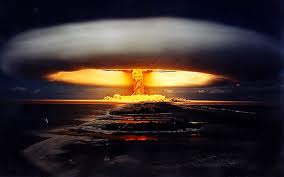In those first minutes, they’ll be stunned. Eyes fixed in a thousand-yard stare, nerve endings numbed. Today’s issue of Le Monde carries a story on nuclear conflict in the Middle East. “They’ll just stand there. Soon, you’ll notice that they are holding their arms out at a 45-degree angle. Your eyes will be drawn to their hands and you’ll think you mind is playing tricks. But it won’t be. Their fingers will start to resemble stalactites, seeming to melt toward the ground. And it won’t be long until the screaming begins. Shrieking. Moaning. Tens of thousands of victims at once. They’ll be standing amid a sea of shattered concrete and glass, a wasteland punctuated by the shells of buildings, orphaned walls, stairways leading nowhere.
Your eyes will be drawn to their hands and you’ll think you mind is playing tricks. But it won’t be. Their fingers will start to resemble stalactites, seeming to melt toward the ground. And it won’t be long until the screaming begins. Shrieking. Moaning. Tens of thousands of victims at once. They’ll be standing amid a sea of shattered concrete and glass, a wasteland punctuated by the shells of buildings, orphaned walls, stairways leading nowhere.
“This could be Tehran, or what’s left of it, just after an Israeli nuclear strike.
“Iranian cities — owing to geography, climate, building construction, and population densities — are particularly vulnerable to nuclear attack, according to a new study, “Nuclear War Between Israel and Iran: Lethality Beyond the Pale,” published in the journal Conflict & Health by researchers from the University of Georgia and Harvard University. It is the first publicly released scientific assessment of what a nuclear attack in the Middle East might actually mean for people in the region. Continue reading “The Middle East nuclear option”